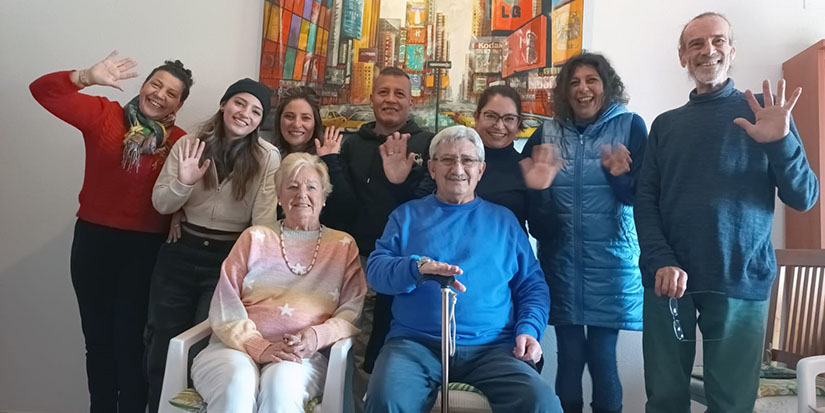Resources for the introduction of SGI-Spain’s discussion meetings
A hundred years of practice in the Land of Perfect Bliss cannot compare to the benefit gained from one day’s practice in the impure world.
↳ On Repaying Debts of Gratitude, in WND-1, page 736. This treatise is one of the five major writings of Nichiren Daishonin. It is dated the twenty-first day of the seventh month of 1276, when the Daishonin had been residing in Minobu for just over two years. The writing of this work was prompted by the news of the death of Dozen-bo, a priest at Seicho-ji Temple in Awa Province, who had been the Daishonin’s teacher since he entered the temple at the age of twelve.[*]
We cannot possibly know all of the challenges others are facing in these difficult times and the struggles they are experiencing. Perhaps their jobs are extremely busy, or they are shouldering heavy responsibilities. They may be facing indescribable hardships.
Earnestly making efforts to find time, to take action, and to meet with people is itself Buddhist practice. This is because the resolve underlying those actions leads to our human revolution and transforms our state of life. And by making such efforts amid our own busy schedules, we are able to empathize with others’ difficulties and inspire them with just a few simple encouraging words or a single visit.
Practicing Buddhism is an exercise of our right to be happy. (…) As a result, we can accumulate immeasurable benefit.
Earnestly making efforts to find time, to take action, and to meet with people is itself Buddhist practice. (…) As a result, we can accumulate immeasurable benefit.
If we remain focused on our limited personal desires and wishes, we cannot harness that power. We will be confined to a small, narrow self.
The Mystic Law allows us to make positive use of all our experiences, even the ones from before the time we embarked on the path of Buddhist practice.
From the standpoint of Buddhism, it is no coincidence that we have encountered the Daishonin’s teachings at this particular time and joined the movement for kosen-rufu. The karmic bonds of mentor and disciple are eternal. Based on the perspective of life spanning the three existences of past, present, and future, we are all like-minded friends linked by deep ties, who have chosen to be born in this world to spread the Mystic Law.[1]
The passage from the Daishonin’s writings which opens this section also appears in chapter “Bold Advance” of The New Human Revolution. Responding to a youth who asks about the difficulties he has finding the time to do kosen-rufu activities, Shin’ichi Yamamoto mentions the following passage and comment:
The benefit we accumulate from striving in our Buddhist practice under demanding circumstances is all the greater for them (…). “When we are busy at work, we tend to think, ‘I’ll concentrate on my Soka Gakkai activities when I have some free time.’ But that’s a mistake. No matter how busy you are at work, the important thing is that you wholeheartedly contribute in whatever way you can. The fact is, if you retreat in faith, you’ll find you also reach an impasse in your job.
“Nichiren Daishonin writes: ‘Buddhism is like the body, and society like the shadow. When the body bends, so does the shadow.’[2] Only when the ‘body’—our Buddhist practice—is firmly established, will the ‘shadow’—our work and our lives in society—follow suit. (…) In the process, you will be able to develop yourself, transform your state of life, and do your human revolution, accumulating benefit and good fortune along the way.”[3]

This discussion group from Málaga has turned 1 in January. The name of the municipality of the beautiful region of Axarquí in which they meet, Torrox, is believed to come from a romance term which means “tower.” Nichiren Daishonin writes “whether eminent or humble, high or low, those who chant Nam-myoho-renge-kyo are themselves the treasure tower” (On the Treasure Tower, WND-1, page 299). We believe that the photography they have sent to us is a true image of this statement. Congratulations!
Mailbox: prensa@ediciones-civilizacionglobal.com
[*] ↑ This explanation differs from that included in the printed edition, where an erroneous one (corresponding to another writing) was introduced. We apologize for the inconvenience.
[1] ↑ Passages from IKEDA, Daisaku: “To My Friends of Each Division Engaged in Our Shared Truggle. The Men’s Division,” Daibyakurenge, March 2019.
[2] ↑ A Comparison of the Lotus and Other Sutras, WND-1, page 1039.
[3] ↑ IKEDA, Daisaku: The New Human Revolution, vol. 26, chapter 4, installment 55.

